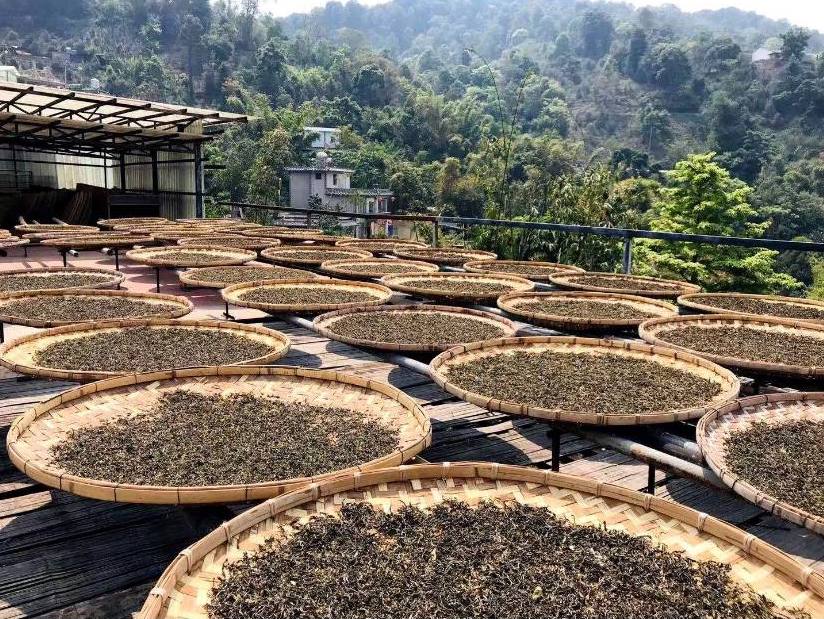
What is the technology for producing Ripe Puer?
Share
Producing Ripe Puerh tea (Shu Pu-erh) involves a carefully controlled fermentation process that accelerates the aging of the tea, making it ready to drink much sooner than Raw Pu-erh (Sheng Pu-erh). Here is a detailed step-by-step breakdown of how ripe pu-erh is made:
1. Harvesting the Tea Leaves:
The process begins with harvesting mature leaves from large-leaf tea trees, mainly found in Yunnan Province, China. The leaves are picked from spring to autumn, with spring leaves generally considered of higher quality.
2. Withering:
The freshly picked tea leaves are spread out under the sun or in a shaded area to wither. This step reduces moisture and prepares the leaves for the next stage of processing.
3. Kill-Green (Sha Qing):
The leaves undergo a "kill-green" process where they are briefly pan-fried or steamed to stop enzymatic oxidation. This step preserves the green color and fresh aroma of the leaves.
4. Rolling (Rounian):
The leaves are then rolled to break the cell walls, allowing the juices to come out, which helps in developing flavor and aroma during fermentation. This step is done either manually or using machines.
5. Sun Drying:
After rolling, the leaves are spread out in the sun to dry. This step reduces the moisture content further, making the leaves suitable for the fermentation process.
6. Wet Piling (Wo Dui) – Main Fermentation Step:
This is the most crucial step in producing ripe pu-erh:
- Piling the Leaves: The dried leaves are piled in large heaps on the floor, typically in a controlled indoor environment. The size of the pile can vary but often reaches up to one meter in height.
- Moistening the Pile: Water is sprinkled over the piled tea leaves to create the right conditions for microbial fermentation. The temperature and humidity are closely monitored to ensure proper fermentation.
- Turning the Pile: The piles are regularly turned to ensure even fermentation and prevent overheating. The turning also helps control the moisture and oxygen levels, which are crucial for the microbes responsible for fermentation.
- Fermentation Duration: This process lasts anywhere from 45 to 60 days, though it can sometimes extend longer, depending on the desired flavor profile. During this period, the leaves darken, and the characteristic earthy, mellow taste of ripe pu-erh develops.
7. Drying After Fermentation:
Once fermentation is complete, the tea is spread out and dried again, either by sun drying or with the help of low-temperature drying machines. This step stabilizes the tea, halting further fermentation.
8. Sorting and Grading:
The dried leaves are sorted and graded according to their size, color, and quality. Larger, whole leaves are generally considered higher quality, while broken or smaller leaves are often used for lower-grade pu-erh.
9. Compression into Cakes (Optional):
- The tea can be left loose or compressed into various shapes, such as cakes (bing), bricks (zhuan), or nests (tuo). To compress the tea:
- The leaves are steamed briefly to soften them, making them pliable.
- The soft leaves are then placed in molds and pressed using hydraulic or stone presses.
- The compressed tea is dried to remove any remaining moisture, ensuring it is stable for storage.
10. Aging and Storage:
- While ripe pu-erh is ready to drink soon after production, it can also be aged further to develop a smoother, richer flavor. Proper storage involves keeping the tea in a cool, dry, and well-ventilated environment, away from strong odors and direct sunlight.
Key Characteristics of Ripe Pu-erh Production:
- The unique wet piling process is what distinguishes ripe pu-erh from raw pu-erh, as it simulates the natural aging process, allowing the tea to acquire its distinctive earthy and mellow flavor quickly.
- The fermentation involves a complex interplay of microbial activity, where beneficial bacteria and fungi contribute to the tea's flavor, aroma, and health benefits.
Producing ripe pu-erh is a highly skill-dependent process, requiring experience and careful monitoring to ensure the tea develops the desired taste profile without any off-flavors.
